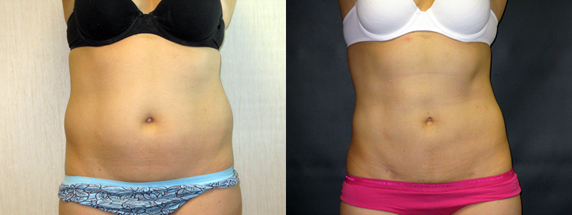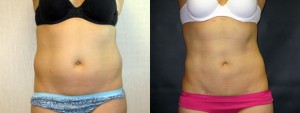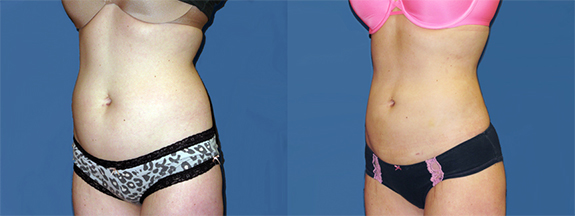Liposuction
Have you heard about Liposuction?Liposuction – Milwaukee, Glendale & Waukesha, WI
What waistline?
 Liposuction is a body contouring procedure that removes unwanted fat deposits that have not been responsive to traditional weight loss methods. Liposuction is one of the most poplar cosmetic surgeries, consistently ranking first among men and second among women. Liposuction is commonly used to improve the contour of the abdomen, flanks, hips, thighs, chest, back, knees, arms, neck, and chin. Liposuction is not a substitute for diet and exercise, and is not a weight loss procedure. The best results are obtained in active individuals with a relatively normal body weight and good skin quality. Although there are several different modalities of liposuction currently available (standard tumescent, power-assisted, ultrasonic-assisted, and laser-assisted) the results depend more on the experience and technique of the surgeon, than on the actual modality of liposuction used.
Liposuction is a body contouring procedure that removes unwanted fat deposits that have not been responsive to traditional weight loss methods. Liposuction is one of the most poplar cosmetic surgeries, consistently ranking first among men and second among women. Liposuction is commonly used to improve the contour of the abdomen, flanks, hips, thighs, chest, back, knees, arms, neck, and chin. Liposuction is not a substitute for diet and exercise, and is not a weight loss procedure. The best results are obtained in active individuals with a relatively normal body weight and good skin quality. Although there are several different modalities of liposuction currently available (standard tumescent, power-assisted, ultrasonic-assisted, and laser-assisted) the results depend more on the experience and technique of the surgeon, than on the actual modality of liposuction used.
Liposuction is safe, produces significant improvements in shape and contour, and is associated with a high level of patient satisfaction. If you have a problem area of fat that is holding you back, and it just won’t go away no matter what you do, give us a call. We have years of experience and many happy patients who have trusted us to give them a body they can be proud of.
Think you might need a Tummy Tuck ?
What is Liposuction?
Liposuction is designed to remove localized areas of fat in patients with a relatively normal body weight. Liposuction is commonly used to improve the appearance and contour of the chest, stomach, flanks, back, extremities, neck, and chin…almost anywhere on the body where there is excess fat. Although liposuction is not a substitute for diet and exercise, liposuction can remove those stubborn areas of fat that do not respond to traditional methods of weight loss. The results achieved with liposuction have been shown to be better in those individuals who are active and exercise regularly before and after their liposuction procedure. Patients will therefore experience their best result by reaching an optimal body weight they are able to achieve prior to surgery, and then maintaining that weight following surgery.
According to the American Society for Aesthetic Plastic Surgery statistics, there were 414,335 liposuction procedures performed in 2016, making liposuction the most popular cosmetic surgical procedure; this represents a 5% increase in liposuction procedures over the previous year. The consistent popularity of liposuction is reflective of the quality of the results that can be achieved, the safety profile of the procedure, and the improved self-image that people feel following the procedure.
Who is the Ideal Candidate for Liposuction?
The best candidates for liposuction have pockets of excess fat, but are also physically healthy with a relatively normal body weight. Age is usually not a criterion for liposuction, but older patients may have diminished skin elasticity and may not achieve the same results as younger patients. A better post-operative shape and contour will occur in individuals who have firm, tight elastic skin. And results will be better maintained in those individuals who have a (low) stable body weight and can maintain that same weight after surgery.

29 year old woman dissatisfied with her abdominal shape. Four month post-operative photos demonstrate good results after aspiration of approximately 650cc of fat from each flank and over 1000cc of fat from the abdomen.
Loose and/or hanging skin won’t reshape to the body’s new contours after liposuction, and these individuals may require a surgical procedure to remove the excess skin (such as a tummy tuck, arm lift, thigh lift, etc). Liposuction is, however, often combined with a tummy tuck to improve the overall shape. Think you might need a tummy tuck ?
Liposuction is not a weight loss procedure – it is a shaping and contouring procedure. Liposuction is not recommended if you’ve had recent surgery in the area to be sculpted, if you have poor blood circulation in that area, or if you have heart or lung disease. You should also understand that liposuction by itself will usually not improve the dimpled skin known as cellulite; though some plastic surgeons offer other techniques that may improve this condition.
What Areas can Liposuction Target?
We are often asked, “What areas can be treated with liposuction?” There are many areas we can target including:
Chest
Abdomen
Flank / Waist
Back Rolls / Bra Fat
Hips
Thighs
Knees
Buttocks
Chin / Submental
Neck
Upper Arms
What is the Liposuction Procedure Like?
There are several modalities of liposuction currently available. Standard tumescent liposuction, power-assisted liposuction, ultrasound-assisted liposuction, and laser-assisted liposuction are the most widely used. It is important to understand that the results of liposuction surgery depend much more on the experience and technique of the surgeon, and less on the actual modality of liposuction used. This is why it is important to select a surgeon with experience in liposuction who will spend the time necessary to provide a thorough treatment.
Liposuction of smaller areas can sometimes be performed with a combination of intravenous sedation and a regional local anesthetic. If a larger volume of fat is to be removed, then a general anesthetic is more appropriate. Liposuction requires several hours depending on the extent of surgery. Suctioning of the fat is performed using a specialized cannula ( a thin hollow tube), connected via tubing, to a machine that creates a vacuum. Several small incisions are created to access the area of treatment. A wetting solution is then infused into the fat prior to suctioning. The liposuction cannula is then inserted through the same incisions. The surgeon manipulates the cannula within the deeper layer of fat, breaking up the fat and suctioning it out. The cannula sites are closed with a few sutures, and a compression garment is placed. The compression garment helps reduce swelling, minimizes the risk for a fluid collection, improves blood flow, decreases post-operative pain, and helps to reshape the treated area. Compression garments are usually worn for at least 6 weeks after surgery, but your surgeon can provide more information.
How Much Does Liposuction Cost?
Liposuction costs can vary widely, with the average surgeon’s fee being approximately $3,300 according to the 2016 statistics from the American Society of Plastic Surgeons. The cost of liposuction is likely to vary based upon the number of body areas treated, and the amount of fat that needs to be removed from each area. There will be additional charges for anesthesia, the operating room facility, any necessary labs and tests, and any other related expenses. Liposuction is considered a ‘cosmetic’ procedure that is not covered by insurance. We do offer CareCredit financing if that is something you wish to take advantage of.
Contact Dr. Dembny’s Office For More Information
Please call us if you would like more information or to schedule a consultation : 414-443-0033
Post-Operative Instructions & Information for Liposuction
When liposuction is performed on the trunk or extremities, a post-surgical compression garment is recommended for up to 6 weeks after surgery. This garment helps shape and contour the treated area, in addition to reducing swelling, improving blood flow, minimizing the risk of fluid collections, and decreasing post-op discomfort. The best garment is a specifically designed post-surgical garment which is selected to fit your body. Your doctor can discuss this in more detail.
Patients are not allowed to drive themselves home after surgery, and must receive a ride from a friend or family member.
At discharge you will be given instructions regarding incision care, and how to bathe. Patients are able to shower the day after surgery.
Patients return to the doctor’s office about 7 – 10 days after surgery; and then again at one and three months after surgery.
Sutures will be placed at the cannula sites, the number and location of which will be discussed with you prior to surgery. These sutures are removed about one week following surgery.
Bruising usually resolves within 2 weeks after surgery, but can persist longer. A reasonable amount of the swelling improves over the initial 4 weeks, but it may take 3-4 months for all the swelling to resolve. Numbness can remain for up to 4 months or more.
Strenuous activities should be avoided for approximately 2-3 weeks after surgery. Your doctor will instruct you when to begin a gradual return to activities.
Patients may resume driving when they no longer require narcotic pain medication. If narcotic pain medication is not required, then Extra Strength Tylenol is recommended during the first week after surgery.
Non-steroidal anti-inflammatory drugs (NSAIDs) such as ibuprofen [Advil, Motrin] and naproxen [Aleve, Naprosyn] should not be utilized during the first week after surgery to minimize post-operative bleeding and bruising. However, after the first week these medications work well to treat any discomfort present.
Patients may return to their (non-strenuous) job within several days after surgery, provided it does not involve excessive movements of the treated area(s).
Liposuction Abdomen & Flanks
 This 29 year old woman (5’8″ | 168 lbs) disliked her central abdominal fullness and protruding flanks. Examination demonstrated mild-to-moderate lipodystrophy of the abdomen and flanks, with no stretch marks. Four and one-half month post-operative photographs show the results of power-assisted liposuction of the flanks and abdomen. She has a great result, continues to exercise, and is thrilled with her abdominal contour.
This 29 year old woman (5’8″ | 168 lbs) disliked her central abdominal fullness and protruding flanks. Examination demonstrated mild-to-moderate lipodystrophy of the abdomen and flanks, with no stretch marks. Four and one-half month post-operative photographs show the results of power-assisted liposuction of the flanks and abdomen. She has a great result, continues to exercise, and is thrilled with her abdominal contour.
Read what patients are saying
Liposuction Lateral Thighs
 48 year old woman (5´5″ | 193 lbs) was unhappy with the appearance of her large saddlebags despite exercise and weight loss. She has several relatives who have very broad hips, and is bothered by how disproportionate her lower body is compared to her upper body. She must wear pants that are several sizes larger than what properly fits her waist, and even then the hip area is often too tight. 7-week post-operative photographs show the results. A small amount of residual swelling persists. She has lost 15 pounds, her pant size has dropped three sizes, and she is very happy. See more patient pictures.
48 year old woman (5´5″ | 193 lbs) was unhappy with the appearance of her large saddlebags despite exercise and weight loss. She has several relatives who have very broad hips, and is bothered by how disproportionate her lower body is compared to her upper body. She must wear pants that are several sizes larger than what properly fits her waist, and even then the hip area is often too tight. 7-week post-operative photographs show the results. A small amount of residual swelling persists. She has lost 15 pounds, her pant size has dropped three sizes, and she is very happy. See more patient pictures.

